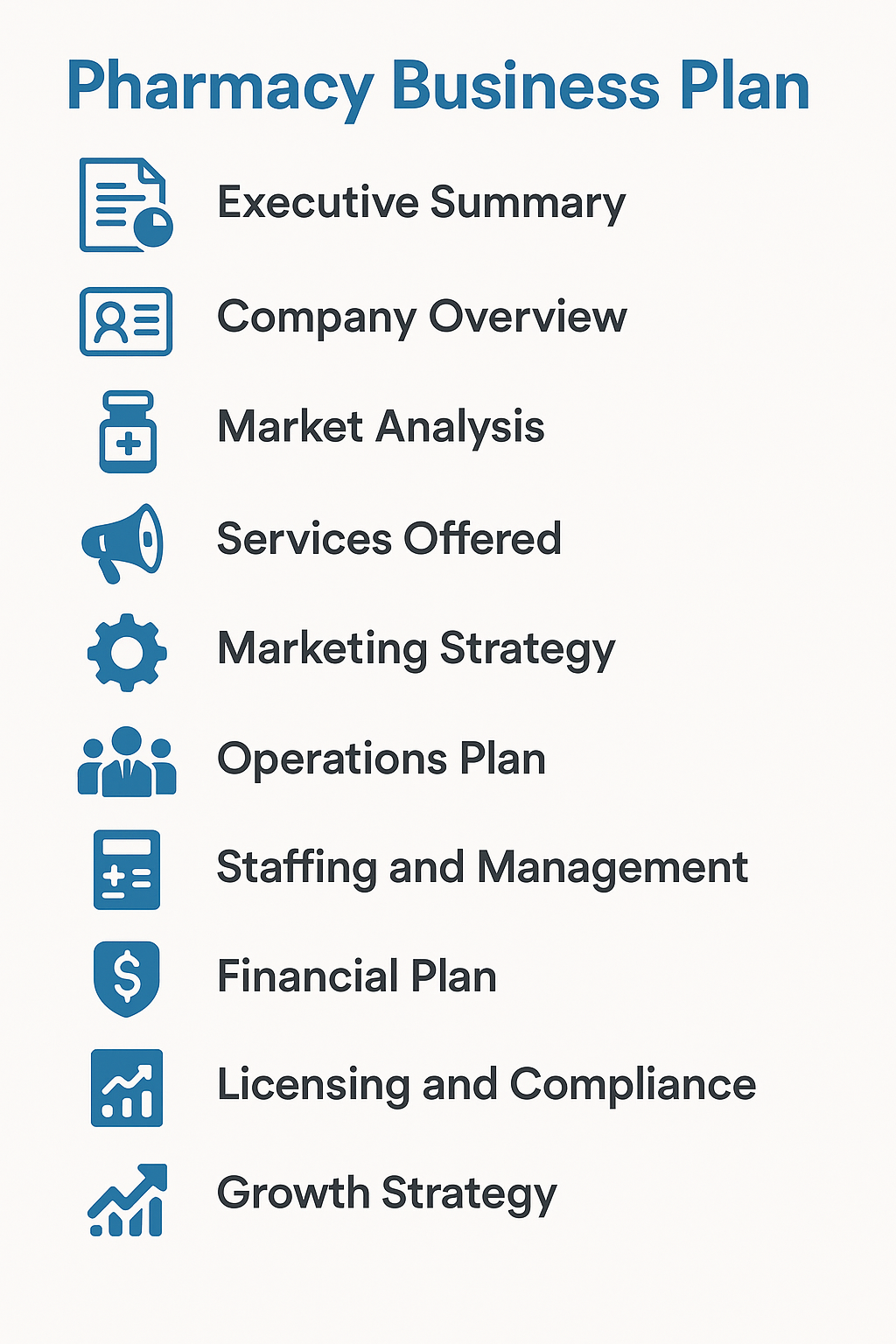Table of Contents
Starting your own pharmacy can be one of the most rewarding ventures you can undertake – both financially and in terms of community service. However, success in this industry is not just about stocking your medicines. A well-structured pharmacy business plan is essential to turning your vision into a thriving business.
In this guide, we’ll walk you through everything you need to include in a pharmacy business plan to ensure you’re on the right track from day one.
What is a Pharmacy Business Plan?
A pharmacy business plan is a formal document that outlines your goals, target market, startup costs, operations, staffing, and growth strategies. It serves as your roadmap for starting and running a successful pharmacy business. It is also a key tool for securing funding and approval from banks, investors, and regulatory agencies.
Why Do You Need a Pharmacy Business Plan?
A detailed pharmacy business plan helps you:
• Define your pharmacy’s vision and goals
• Understand your competition
• Secure funding from investors or banks
• Comply with healthcare and pharmacy regulations
• Plan inventory, staffing, and marketing strategies
• Track milestones and measure success
Without a business plan, it’s easy to overlook essential elements that could lead to financial losses or regulatory penalties.
Key Elements of a Pharmacy Business Plan
Let’s break down the major sections every pharmacy business plan must include:

1. Executive Summary
This section gives a snapshot of your entire pharmacy business plan. It should briefly cover:
- The business name and location
- The type of pharmacy (retail, online, specialty, compounding)
- Vision and mission statements
- Summary of financial projections
- The purpose of the plan (e.g., funding request)
Example:
“Health First Pharmacy will be a full-service retail pharmacy located in Dallas, Texas, offering prescription medications, over-the-counter drugs, health supplements, and health consultations.”
2. Company Overview
This section explains the structure of your business, its legal entity, ownership, and the reason for starting it.
Include:
- Business structure (LLC, Corporation, Sole Proprietor)
- Ownership details
- Location and size of the store
- The problem your pharmacy will solve
3. Market Analysis
Understanding the local market is vital for your pharmacy business plan. Perform detailed research on:
- Local demographics and health trends
- Competitors in the area
- Potential customer base (age, health needs, income levels)
- Market demand for pharmacy services
- SWOT Analysis (Strengths, Weaknesses, Opportunities, Threats)
Example SWOT for a New Pharmacy:
- Strengths: Convenient location, experienced pharmacist
- Weaknesses: New to market, limited brand recognition
- Opportunities: Aging population, chronic disease management
- Threats: Big chain competition, changing regulations
4. Services Offered
Clearly outline what your pharmacy will provide. Common offerings include:
- Prescription medications
- Over-the-counter (OTC) drugs
- Immunizations and vaccinations
- Health screenings (BP, glucose, cholesterol)
- Medication Therapy Management (MTM)
- Home delivery or drive-through services
- Compounding services (if applicable)
Having a diverse range of services makes your pharmacy business plan more robust and appealing to investors.
5. Marketing Strategy
A marketing strategy is essential for bringing in customers. In this section of your pharmacy business plan, cover:
- Branding (logo, store design, slogan)
- Promotions and offers (e.g., free blood pressure checks)
- Online presence (website, social media)
- Local advertising (flyers, newspapers, radio)
- Community engagement (health camps, partnerships with clinics)
- Loyalty programs and mobile app integration
You can also offer digital prescription refills and reminders to enhance patient convenience.
6. Operations Plan
Your operations plan explains how your pharmacy will run on a daily basis. Cover areas like:
- Store hours and layout
- Supplier partnerships
- Inventory management system
- Prescription processing workflow
- Staffing schedule
- Safety and compliance protocols
Implementing modern technology and automation can boost your pharmacy’s efficiency and customer satisfaction.
7. Staffing and Management
List your team structure, hiring needs, and roles:
- Licensed Pharmacists
- Pharmacy Technicians
- Customer Service Representatives
- Billing Specialists
- Inventory Managers
Include training plans and continuing education programs for staff to stay compliant with state laws and best practices.
8. Financial Plan
This is one of the most critical components of any pharmacy business plan. Investors will examine this section closely. Include:
- Startup Costs: Rent, licenses, insurance, inventory, equipment
- Revenue Projections: Based on prescriptions/day and average sales
- Operating Expenses: Salaries, rent, marketing, utilities
- Break-even Analysis: When you expect to turn a profit
- Cash Flow Forecast: Month-by-month for at least one year
- Funding Requirements: Amount needed and how it will be used
9. Licensing and Compliance
Your pharmacy business plan must show awareness of legal obligations, including:
- State pharmacy board registration
- DEA license (for controlled substances)
- NPI number
- HIPAA compliance
- OSHA safety requirements
- Business insurance policies
Failing to meet legal requirements can result in heavy fines or closure.
10. Growth Strategy
Investors want to know how you’ll grow your pharmacy. Consider:
- Adding more services (like clinical consultations)
- Partnering with local physicians or hospitals
- Opening multiple locations
- Launching an e-commerce platform
- Franchise model development
- Investing in digital marketing and telepharmacy
Your pharmacy business plan should reflect both short-term goals and long-term vision.
Tips for Writing a Pharmacy Business Plan
- Use clear and simple language: Avoid medical jargon when unnecessary.
- Back your claims with data: Include market statistics, research findings, or case studies.
- Keep it professional: Use a formal tone, neat formatting, and visuals if possible.
- Review and update regularly: Your business plan should evolve as your business grows.
- Include visuals: Charts, graphs, and infographics enhance readability.
Common Mistakes to Avoid
- Ignoring competition in the market analysis
- Underestimating costs and overestimating revenue
- Lacking a clear marketing strategy
- Failing to outline compliance and licensing details
- Not updating the plan regularly
Final Thoughts
Creating a detailed and actionable pharmacy business plan is the foundation of a successful pharmacy. It not only helps you plan every aspect of your operations, but it also gives potential investors the confidence to back your venture.
Whether you’re starting a small local pharmacy or a chain of stores, a solid pharmacy business plan can mean the difference between success and struggle.
Start writing your plan today and pave the way for a healthy community and a thriving business!
FAQs about Pharmacy Business Plan
1. What is the most important part of a pharmacy business plan?
2. How much money is needed to start a pharmacy in the U.S.?
3. Do I need a business plan if I’m buying a franchise pharmacy?
4. Can I write my own pharmacy business plan?
5. How often should I update my pharmacy business plan?
Disclaimer:
This blog post is for informational purposes only and does not constitute legal or medical advice. Please consult appropriate professionals for specific guidance on starting a pharmacy business.

